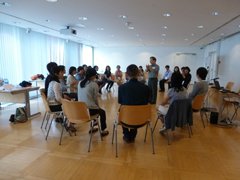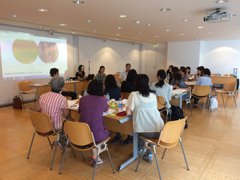The Work to Create a Place for Learning
The Japan Cultural Institute in Paris
FUJIMITSU Yuko
The Work of Designing a Training Program
The primary job of the Japanese-Language Chief Advisor (hereinafter “Advisor”) is the planning, development, and implementation of training sessions to support the learning of teachers. In this report I will cover the training sessions held for the people involved in Japanese-language education throughout Europe, as part of the training activities of the Japan Cultural Institute in Paris, and write about my job as an Advisor designing that training.
Training for Colleagues Throughout Europe to Discover the Latest Practical Educational Research
Every early July, the gathering of the “Japanese-Language Education Network in Europe” is held at the Japan Cultural Institute in Paris for a small number of roughly 15 participants from among those who apply. Those participants consist of motivated teachers from throughout Europe, and the two-day intensive training allows them to learn about the latest research on practical education while considering how to apply it to their own classrooms. Themes proposed for the AY2017 session included “Education on Intercultural Literacy,” “Active Learning,” and “Full Body Learning,” and instructors practicing educational approaches related to the themes were invited from Japan with the cooperation of Association pour la MCJP (the Association for the Japan Cultural Institute in Paris). Seventeen teachers from the five countries of the UK, Netherlands, Italy, Germany, and France participated in this opportunity to engage in friendly competition while learning together.
Maximizing Training Effectiveness
The Advisor must work to improve the training through a variety of ways so that it serves as a meaningful opportunity for learning, and designing the topics beforehand is an important part of that. In order to promote more exchange between participants, the participants, instructors, and administrative staff were all required to share a self-introductory message before the start of the AY2017 “Japanese-Language Education Network in Europe.” Several tasks were also issued beforehand to help maximize the effect of the training. One of those tasks was to have the participants compile a record of any educational activities they had used that were related to the training themes. The records submitted were then shared with all members, who were asked to come up with questions for each other regarding their respective activities. The participants were also provided with academic papers and other research written by the instructors to read and then come up with questions or comments for the instructors as a way to cultivate a shared understanding of the themes. Finally, on the first day of the training, the participants were required to discuss and choose the most important questions before beginning the lectures.

One scene from the AY2017 “Japanese-Language Education Network in Europe”

Another scene from the AY2017 “Japanese-Language Education Network in Europe”
The aim of the training is to deepen the teachers’ understanding of the latest practical educational research, learn activity methodologies through experience to use in the classroom, and to apply those practices to improve their own teaching. The two-day training involves carrying out a cycle of activities several times, including experiencing participatory activities, conceptualization of those activities through a lecture, reflection and sharing, and finally discussion and exchange. While I do my best to keep the point of the training in mind, the actual schedule details are adjusted flexibly according to the progress and situation of each session.
Post-Training Reflection
The participants were given a questionnaire at the end of the training, and of the 17 participants, 15 gave a rating of “Very satisfied” for the overall training, while the remaining two gave a rating of “satisfied.” Many participants commented on the results of the training, praising the richness of the content packed into the short two-day period. Some of the reasons given were that the learning was prepared for with tasks given in advance, that there was a good balance of input of knowledge and theory with output through activities and experience (including individual introspection and group sharing and cooperation), and that the training was designed for flexibility with the content on day two being adjusted according to the results of day one. The participants were always at the center of training, and there was even one comment that “we learned about active learning through active learning.” In addition to the questionnaire, another activity carried out at the end of the training was for the participants to add captions together to an album of photographs following the training from start to finish as a way to share what they learned and internalized. This “Joint Photo Report” was edited by the Japanese-Language Assistants on the training team and is now available on the Japanese teacher’s page of the website of the Japan Cultural Institute in Paris.
Forming a Community for Sharing Practice
We proposed the idea of having the participants sharing the activities they put into practice after redesigning them based on the training, and as a result, we started receiving one voluntary practice report after the other from participants six months later. One individual who themselves is involved in training teachers gave a report on a teacher training workshop they held. Others shared video of research workshops at universities or institutions of continuing education. In response, we created a platform to share 10 of the practice reports we received voluntarily from the training participants. We used an online communication tool to do so to encourage active posting of comments and replies regarding the reports. There are currently 15 members from throughout Europe participating in this online space.
Development into an Online Study Group
I then suggested to this small community that we hold an online study group to discuss classroom practice, to which they agreed readily, and we subsequently decided to do so using an online meeting system. We will hold the meeting on a weekday night from 8:00 to 9:00 PM so as not to interfere with anyone’s work, and will have a member from the Netherlands speak about their practice as the first resource person. Teachers from the Netherlands, France, Germany, the UK, and Italy will then discuss via the free online meeting system. I expect this online study group to develop significantly in the future because participants can easily join from home or via smartphone without spending time traveling.
What Training Means for Me
What do you seek in a training program? My hope as someone who designs training is to create time to acquire learning skills and expertise in addition to knowledge of the subject being taught. I want the training to be an opportunity for the participants to enjoy meeting and interacting with each other, and build relationships to share life experience and wisdom with each other. I want it to be something that brings about positive change in the classroom practice of each participant. I work with the hope that such a place of learning will grow in a way that fits the context of Europe. If the training offers a challenge to the participants, then it will also serve as an opportunity for those who prepare it to learn as well. There is no doubt that the process itself, from preparation to follow-up, is a series of intellectual challenges and opportunities to renew learning. I feel that this is both the most difficult part and the real pleasure of this job.
- What We Do Top
- Arts and Cultural Exchange [Culture]
- Japanese-Language Education Overseas [Language]
- Japanese-Language Education Overseas [Language] Top
- Learn Japanese-language
- Teach Japanese-language
- Take Japanese-Language Test
- Know about Japanese-language education abroad
- The Japanese-Language Institute, Urawa
- The Japanese-Language Institute, Kansai
- Japanese-Language Programs for Foreign Specified Skilled Worker Candidates
- Japanese Language Education for Japanese Children Resident Overseas and for the Descendants of Migrants
- Archives
- Japanese Studies and Global Partnerships [Dialogue]
- JF digital collection
- Other Programs / Programs to Commemorate Exchange Year
- Awards and Prizes
- Publications
